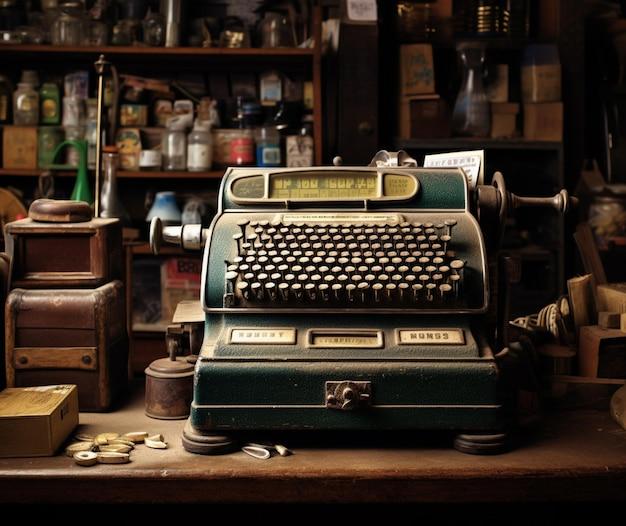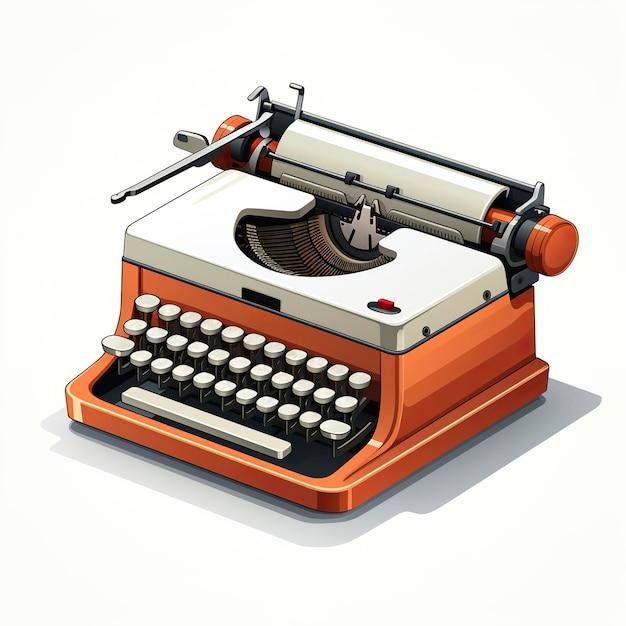Typewriters were once an essential tool for writers, secretaries, and businesses around the world. However, with the advancements in technology, typewriters have gradually become obsolete, making way for the sleek and efficient computers we use today. But the question remains: when did people stop using typewriters?
In this blog post, we will take a nostalgic journey into the world of typewriters, exploring their rise to popularity, the invention of revolutionary models like the Selectric typewriter by IBM, and ultimately, the decline of their usage. We’ll also delve into the value of vintage typewriters, whether they can still be found and purchased, and what you can do with old typewriters now.
So, if you’re a fan of retro gadgets or simply curious about the evolution of writing technology, join us as we explore the fascinating history of typewriters and discover when their keys fell silent.

When Did People Bid Farewell to Typewriters?
Remember the good old days when the clackety sound of typewriters resonated through offices and writing was a physical art? Ah, nostalgia. But when exactly did people start saying “adios” to these marvelous machines? Let’s take a journey through time and discover when typewriters became a relic of the past.
A Shift in Technology: The Digital Revolution
The advent of personal computers in the late 1970s marked the beginning of a digital revolution. Suddenly, people had a more convenient and efficient tool for writing—the computer. With word processing software like WordStar and WordPerfect, typing became a breeze, and there was no need to wrestle with correction tape or experience the agony of a misplaced comma.
Typewriters Struggling to Keep Pace
As personal computers gained popularity, typewriters began to struggle to keep up. Their bulky design and limited functionality made them less appealing in the face of sleek, multifunctional PCs. While some die-hard typewriter enthusiasts held onto their beloved machines, the shift had begun.
The 1980s: The Decade of Transition
By the 1980s, the typewriter’s fate was sealed. The clatter of keys was gradually replaced by the gentle clicks of computer keyboards. Sure, a few dedicated individuals still tapped away on typewriters, but their numbers dwindled as PCs became more affordable and user-friendly.
Typewriter Manufacturers Call It Quits
In the early 2000s, typewriter manufacturers began to admit defeat. Companies like Smith Corona and Brother slowly discontinued their typewriter lines, acknowledging that the digital era had eclipsed their once-mighty contraptions. It was a somber moment for enthusiasts, but a clear sign that typewriters had become relics of a bygone era.
Typewriter Tributes: A Niche Phenomenon
Despite the typewriter’s decline, a devoted community of collectors and enthusiasts still cherishes these timeless machines. Typewriter enthusiasts gather at clubs, exhibitions, and online forums to celebrate their love for nostalgia and the click-clack of typewriter keys. While these tributes keep the spirit alive, they’re more of a homage than a sign of typewriters regaining their former glory.
So, when did people stop using typewriters? The decline started in the late 1970s with the rise of personal computers and took a significant tumble in the 1980s as PCs became more accessible. By the early 2000s, typewriter manufacturers admitted defeat, ultimately leading to the typewriter’s ceremonial retirement. Today, typewriters remain a cherished relic, living on in the hearts of collectors and retro enthusiasts who proudly claim, “Once a typist, always a typist!”

FAQ: When Did People Stop Using Typewriters?
In this comprehensive FAQ-style subsection, we’ll address some common questions about typewriters. From the reasons behind their decline to their current market value, we’ve got you covered. So, grab your typing fingers, adjust your carriage, and let’s dive in!
When Did People Stop Using Typewriters
Typewriters began to fade from common use in the late 1980s and early 1990s. As computers became more accessible and affordable, people started transitioning to word processors and eventually to laptops and desktop computers. Today, typewriters are cherished as nostalgic relics or unique collector’s items.
What Is the Best Typewriter to Buy
Choosing the best typewriter depends on your personal preferences and requirements. If you’re a vintage lover, a classic typewriter from brands like Remington, Smith Corona, or Olympia might be your calling. On the other hand, if you prefer a more modern experience, you can explore electric typewriters or even sleek typewriter-inspired mechanical keyboards for your computer.
Who Invented the Selectric Typewriter
The Selectric typewriter, a revolutionary machine that introduced a spherical typing element instead of individual type bars, was invented by the brilliant minds at IBM. It was introduced in 1961 and quickly gained popularity for its enhanced typing speed, accuracy, and ergonomic design.
How Do You Use the IBM Typewriter
Using the IBM Selectric typewriter is straightforward. Place a sheet of paper on the platen, adjust the margins if needed, and press the keys to type. The Selectric’s unique rotating ball design ensures smooth and precise typing. Just remember to regularly change the ink ribbon and keep the machine in good working condition for optimal performance.
How Much Did a Typewriter Cost in 1900
In 1900, typewriters varied in price depending on the brand and model. Manual typewriters could cost anywhere from $50 to $200, which is equivalent to $1,600 to $6,400 in today’s currency. High-end machines with additional features or electric typewriters were pricier, reaching up to $500 ($16,000 today).
How Much Should I Pay for a Typewriter
The cost of typewriters nowadays largely depends on their condition, brand, and rarity. Vintage typewriters in good working condition can range from $50 to a few hundred dollars. However, rare models or those with historical significance can command higher prices among collectors. Ultimately, it’s worth exploring local vintage shops, online marketplaces, or even estate sales for a good deal.
What Does “Selectric” Mean
“Selectric” is a coined term that combines “select” and “electric.” It aptly describes the IBM Selectric typewriter, which allowed users to easily select characters and type electrically. The Selectric typewriter was a game-changer in the industry due to its innovative technology.
How Much Is an Old Smith Corona Typewriter Worth
The value of an old Smith Corona typewriter depends on factors such as age, model, condition, and rarity. Some vintage Smith Corona typewriters can fetch anywhere from $50 to a few hundred dollars, especially if they are in excellent working condition or have unique features. For accurate pricing, consider consulting typewriter experts or browsing reputable online marketplaces.
What Can You Do with Old Typewriters
While old typewriters might no longer be the primary writing tool, they can still serve various purposes. Embrace your creativity and repurpose them as unique decorative items or give them new life by converting them into keyboard accessories for your computer setup. Alternatively, you can donate them to schools, museums, or even donate them to enthusiasts who appreciate their beauty and historical significance.
Do They Still Sell Typewriters
Yes, typewriters are still available for purchase today. Vintage typewriters can be found in specialized vintage shops, online marketplaces, or at local estate sales. Additionally, some companies produce new typewriters that offer a nostalgic writing experience while incorporating modern features and convenience.
Where Can I Sell a Typewriter
If you’re considering selling a typewriter, you have several options. Online marketplaces like eBay, Etsy, or dedicated typewriter forums are popular platforms for selling both vintage and modern typewriters. Local antique shops, consignment stores, or even hosting a garage sale may also connect you with potential buyers interested in owning a piece of typewriter history.
How Do You Get the Margin on Top of a Paper in a Typewriter
To set the top margin on a typewriter, follow these steps:
- Move the carriage (the part where your paper rests) to the desired top position using the carriage return lever or by gently guiding it with your hand.
- Locate the margin control lever or knob, usually positioned on the right side of the typewriter.
- Adjust the lever or knob to set the desired top margin. Some machines have specific margin markings, while others rely on trial and error.
- Test the margin by typing a few lines. If the text reaches the top edge where you want the margin, you’re all set.
Is There a Market for Old Electric Typewriters
Absolutely! While newer technologies have replaced electric typewriters in everyday use, there’s still a dedicated market for vintage electric typewriters. Collectors, writers who appreciate the old-school experience, and even organizations that use typewriters for various purposes actively seek out electric typewriters. The combination of nostalgia, functionality, and aesthetic appeal makes them sought-after treasures.
When Was the IBM Selectric Invented
The revolutionary IBM Selectric typewriter was invented in 1961. With its unique typing mechanism and sleek design, the Selectric brought a wave of innovation to the typewriter industry. Its popularity soared, leading to the subsequent introduction of various models and improved iterations for several decades.
How Much Did an IBM Selectric Cost
Back in the day, an IBM Selectric typewriter was a considerable investment. In the 1960s, the price varied depending on the specific model and optional features, but generally ranged from $300 to $500. Adjusted for inflation, this would be equivalent to around $2,600 to $4,300 in today’s currency. While expensive, the Selectric’s cutting-edge technology and enhanced typing experience made it a popular choice among professionals.
Now that we’ve explored some frequently asked questions about typewriters, you’re ready to step into the world of these captivating writing machines. Whether you’re a collector, a nostalgic soul, or simply curious, typewriters hold a special place in history and continue to be cherished by the writing enthusiasts of today. Happy typing!
